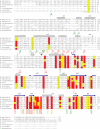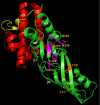Deciphering the catalytic domain of colicin M, a peptidoglycan lipid II-degrading enzyme
- PMID: 20159977
- PMCID: PMC2852976
- DOI: 10.1074/jbc.M109.093583
Deciphering the catalytic domain of colicin M, a peptidoglycan lipid II-degrading enzyme
Abstract
Colicin M inhibits Escherichia coli peptidoglycan synthesis through cleavage of its lipid-linked precursors. It has a compact structure, whereas other related toxins are organized in three independent domains, each devoted to a particular function: translocation through the outer membrane, receptor binding, and toxicity, from the N to the C termini, respectively. To establish whether colicin M displays such an organization despite its structural characteristics, protein dissection experiments were performed, which allowed us to delineate an independent toxicity domain encompassing exactly the C-terminal region conserved among colicin M-like proteins and covering about half of colicin M (residues 124-271). Surprisingly, the in vitro activity of the isolated domain was 45-fold higher than that of the full-length protein, suggesting a mechanism by which the toxicity of this domain is revealed following primary protein maturation. In vivo, the isolated toxicity domain appeared as toxic as the full-length protein under conditions where the reception and translocation steps were by-passed. Contrary to the full-length colicin M, the isolated domain did not require the presence of the periplasmic FkpA protein to be toxic under these conditions, demonstrating that FkpA is involved in the maturation process. Mutational analysis further identified five residues that are essential for cytotoxicity as well as in vitro lipid II-degrading activity: Asp-229, His-235, Asp-226, Tyr-228, and Arg-236. Most of these residues are surface-exposed and located relatively close to each other, hence suggesting they belong to the colicin M active site.
Figures





Similar articles
-
Periplasmic chaperone FkpA is essential for imported colicin M toxicity.Mol Microbiol. 2008 Aug;69(4):926-37. doi: 10.1111/j.1365-2958.2008.06327.x. Epub 2008 Jun 28. Mol Microbiol. 2008. PMID: 18554332 Free PMC article.
-
Toxicity of the colicin M catalytic domain exported to the periplasm is FkpA independent.J Bacteriol. 2010 Oct;192(19):5212-9. doi: 10.1128/JB.00431-10. Epub 2010 Jul 30. J Bacteriol. 2010. PMID: 20675494 Free PMC article.
-
The structure of TolB, an essential component of the tol-dependent translocation system, and its protein-protein interaction with the translocation domain of colicin E9.Structure. 2000 Jan 15;8(1):57-66. doi: 10.1016/s0969-2126(00)00079-4. Structure. 2000. PMID: 10673426
-
On mechanisms of colicin import: the outer membrane quandary.Biochem J. 2018 Dec 12;475(23):3903-3915. doi: 10.1042/BCJ20180477. Biochem J. 2018. PMID: 30541793 Review.
-
Thermodynamic dissection of colicin interactions.Methods Enzymol. 2011;488:123-45. doi: 10.1016/B978-0-12-381268-1.00006-9. Methods Enzymol. 2011. PMID: 21195227 Review.
Cited by
-
A Natural Chimeric Pseudomonas Bacteriocin with Novel Pore-Forming Activity Parasitizes the Ferrichrome Transporter.mBio. 2017 Feb 21;8(1):e01961-16. doi: 10.1128/mBio.01961-16. mBio. 2017. PMID: 28223456 Free PMC article.
-
X-ray structure and site-directed mutagenesis analysis of the Escherichia coli colicin M immunity protein.J Bacteriol. 2011 Jan;193(1):205-14. doi: 10.1128/JB.01119-10. Epub 2010 Oct 29. J Bacteriol. 2011. PMID: 21037007 Free PMC article.
-
Reprogramming microbial populations using a programmed lysis system to improve chemical production.Nat Commun. 2021 Nov 25;12(1):6886. doi: 10.1038/s41467-021-27226-3. Nat Commun. 2021. PMID: 34824227 Free PMC article.
-
Pseudomonas bacteriocin syringacin M released upon desiccation suppresses the growth of sensitive bacteria in plant necrotic lesions.Microb Biotechnol. 2020 Jan;13(1):134-147. doi: 10.1111/1751-7915.13367. Epub 2019 Jan 22. Microb Biotechnol. 2020. PMID: 30672132 Free PMC article.
-
Colicins and Microcins Produced by Enterobacteriaceae: Characterization, Mode of Action, and Putative Applications.Int J Environ Res Public Health. 2022 Sep 19;19(18):11825. doi: 10.3390/ijerph191811825. Int J Environ Res Public Health. 2022. PMID: 36142096 Free PMC article. Review.
References
Publication types
MeSH terms
Substances
LinkOut - more resources
Full Text Sources
Other Literature Sources

